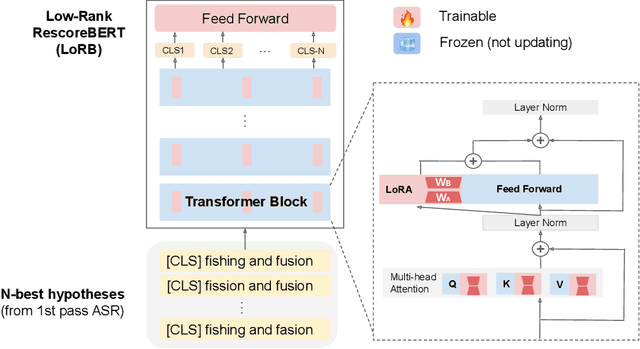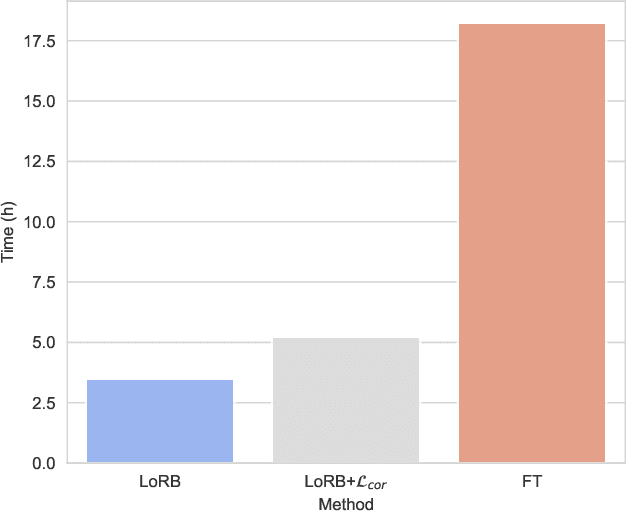Ivan Bulyko
Align-SLM: Textless Spoken Language Models with Reinforcement Learning from AI Feedback
Nov 04, 2024



Abstract:While textless Spoken Language Models (SLMs) have shown potential in end-to-end speech-to-speech modeling, they still lag behind text-based Large Language Models (LLMs) in terms of semantic coherence and relevance. This work introduces the Align-SLM framework, which leverages preference optimization inspired by Reinforcement Learning with AI Feedback (RLAIF) to enhance the semantic understanding of SLMs. Our approach generates multiple speech continuations from a given prompt and uses semantic metrics to create preference data for Direct Preference Optimization (DPO). We evaluate the framework using ZeroSpeech 2021 benchmarks for lexical and syntactic modeling, the spoken version of the StoryCloze dataset for semantic coherence, and other speech generation metrics, including the GPT4-o score and human evaluation. Experimental results show that our method achieves state-of-the-art performance for SLMs on most benchmarks, highlighting the importance of preference optimization to improve the semantics of SLMs.
Speech Recognition Rescoring with Large Speech-Text Foundation Models
Sep 25, 2024Abstract:Large language models (LLM) have demonstrated the ability to understand human language by leveraging large amount of text data. Automatic speech recognition (ASR) systems are often limited by available transcribed speech data and benefit from a second pass rescoring using LLM. Recently multi-modal large language models, particularly speech and text foundational models have demonstrated strong spoken language understanding. Speech-Text foundational models leverage large amounts of unlabelled and labelled data both in speech and text modalities to model human language. In this work, we propose novel techniques to use multi-modal LLM for ASR rescoring. We also explore discriminative training to further improve the foundational model rescoring performance. We demonstrate cross-modal knowledge transfer in speech-text LLM can benefit rescoring. Our experiments demonstrate up-to 20% relative improvements over Whisper large ASR and up-to 15% relative improvements over text-only LLM.
Multi-Modal Retrieval For Large Language Model Based Speech Recognition
Jun 13, 2024



Abstract:Retrieval is a widely adopted approach for improving language models leveraging external information. As the field moves towards multi-modal large language models, it is important to extend the pure text based methods to incorporate other modalities in retrieval as well for applications across the wide spectrum of machine learning tasks and data types. In this work, we propose multi-modal retrieval with two approaches: kNN-LM and cross-attention techniques. We demonstrate the effectiveness of our retrieval approaches empirically by applying them to automatic speech recognition tasks with access to external information. Under this setting, we show that speech-based multi-modal retrieval outperforms text based retrieval, and yields up to 50 % improvement in word error rate over the multi-modal language model baseline. Furthermore, we achieve state-of-the-art recognition results on the Spoken-Squad question answering dataset.
Investigating Training Strategies and Model Robustness of Low-Rank Adaptation for Language Modeling in Speech Recognition
Jan 19, 2024Abstract:The use of low-rank adaptation (LoRA) with frozen pretrained language models (PLMs) has become increasing popular as a mainstream, resource-efficient modeling approach for memory-constrained hardware. In this study, we first explore how to enhance model performance by introducing various LoRA training strategies, achieving relative word error rate reductions of 3.50\% on the public Librispeech dataset and of 3.67\% on an internal dataset in the messaging domain. To further characterize the stability of LoRA-based second-pass speech recognition models, we examine robustness against input perturbations. These perturbations are rooted in homophone replacements and a novel metric called N-best Perturbation-based Rescoring Robustness (NPRR), both designed to measure the relative degradation in the performance of rescoring models. Our experimental results indicate that while advanced variants of LoRA, such as dynamic rank-allocated LoRA, lead to performance degradation in $1$-best perturbation, they alleviate the degradation in $N$-best perturbation. This finding is in comparison to fully-tuned models and vanilla LoRA tuning baselines, suggesting that a comprehensive selection is needed when using LoRA-based adaptation for compute-cost savings and robust language modeling.
Paralinguistics-Enhanced Large Language Modeling of Spoken Dialogue
Jan 17, 2024Abstract:Large Language Models (LLMs) have demonstrated superior abilities in tasks such as chatting, reasoning, and question-answering. However, standard LLMs may ignore crucial paralinguistic information, such as sentiment, emotion, and speaking style, which are essential for achieving natural, human-like spoken conversation, especially when such information is conveyed by acoustic cues. We therefore propose Paralinguistics-enhanced Generative Pretrained Transformer (ParalinGPT), an LLM that utilizes text and speech modalities to better model the linguistic content and paralinguistic attributes of spoken dialogue. The model takes the conversational context of text, speech embeddings, and paralinguistic attributes as input prompts within a serialized multitasking multimodal framework. Specifically, our framework serializes tasks in the order of current paralinguistic attribute prediction, response paralinguistic attribute prediction, and response text generation with autoregressive conditioning. We utilize the Switchboard-1 corpus, including its sentiment labels as the paralinguistic attribute, as our spoken dialogue dataset. Experimental results indicate the proposed serialized multitasking method outperforms typical sequence classification techniques on current and response sentiment classification. Furthermore, leveraging conversational context and speech embeddings significantly improves both response text generation and sentiment prediction. Our proposed framework achieves relative improvements of 6.7%, 12.0%, and 3.5% in current sentiment accuracy, response sentiment accuracy, and response text BLEU score, respectively.
Towards ASR Robust Spoken Language Understanding Through In-Context Learning With Word Confusion Networks
Jan 05, 2024



Abstract:In the realm of spoken language understanding (SLU), numerous natural language understanding (NLU) methodologies have been adapted by supplying large language models (LLMs) with transcribed speech instead of conventional written text. In real-world scenarios, prior to input into an LLM, an automated speech recognition (ASR) system generates an output transcript hypothesis, where inherent errors can degrade subsequent SLU tasks. Here we introduce a method that utilizes the ASR system's lattice output instead of relying solely on the top hypothesis, aiming to encapsulate speech ambiguities and enhance SLU outcomes. Our in-context learning experiments, covering spoken question answering and intent classification, underline the LLM's resilience to noisy speech transcripts with the help of word confusion networks from lattices, bridging the SLU performance gap between using the top ASR hypothesis and an oracle upper bound. Additionally, we delve into the LLM's robustness to varying ASR performance conditions and scrutinize the aspects of in-context learning which prove the most influential.
Discriminative Speech Recognition Rescoring with Pre-trained Language Models
Oct 10, 2023Abstract:Second pass rescoring is a critical component of competitive automatic speech recognition (ASR) systems. Large language models have demonstrated their ability in using pre-trained information for better rescoring of ASR hypothesis. Discriminative training, directly optimizing the minimum word-error-rate (MWER) criterion typically improves rescoring. In this study, we propose and explore several discriminative fine-tuning schemes for pre-trained LMs. We propose two architectures based on different pooling strategies of output embeddings and compare with probability based MWER. We conduct detailed comparisons between pre-trained causal and bidirectional LMs in discriminative settings. Experiments on LibriSpeech demonstrate that all MWER training schemes are beneficial, giving additional gains upto 8.5\% WER. Proposed pooling variants achieve lower latency while retaining most improvements. Finally, our study concludes that bidirectionality is better utilized with discriminative training.
Generative Speech Recognition Error Correction with Large Language Models and Task-Activating Prompting
Oct 10, 2023Abstract:We explore the ability of large language models (LLMs) to act as speech recognition post-processors that perform rescoring and error correction. Our first focus is on instruction prompting to let LLMs perform these task without fine-tuning, for which we evaluate different prompting schemes, both zero- and few-shot in-context learning, and a novel task activation prompting method that combines causal instructions and demonstration to increase its context windows. Next, we show that rescoring only by in-context learning with frozen LLMs achieves results that are competitive with rescoring by domain-tuned LMs, using a pretrained first-pass recognition system and rescoring output on two out-of-domain tasks (ATIS and WSJ). By combining prompting techniques with fine-tuning we achieve error rates below the N-best oracle level, showcasing the generalization power of the LLMs.
Low-rank Adaptation of Large Language Model Rescoring for Parameter-Efficient Speech Recognition
Sep 26, 2023



Abstract:We propose a neural language modeling system based on low-rank adaptation (LoRA) for speech recognition output rescoring. Although pretrained language models (LMs) like BERT have shown superior performance in second-pass rescoring, the high computational cost of scaling up the pretraining stage and adapting the pretrained models to specific domains limit their practical use in rescoring. Here we present a method based on low-rank decomposition to train a rescoring BERT model and adapt it to new domains using only a fraction (0.08%) of the pretrained parameters. These inserted matrices are optimized through a discriminative training objective along with a correlation-based regularization loss. The proposed low-rank adaptation Rescore-BERT (LoRB) architecture is evaluated on LibriSpeech and internal datasets with decreased training times by factors between 5.4 and 3.6.
Personalization for BERT-based Discriminative Speech Recognition Rescoring
Jul 13, 2023



Abstract:Recognition of personalized content remains a challenge in end-to-end speech recognition. We explore three novel approaches that use personalized content in a neural rescoring step to improve recognition: gazetteers, prompting, and a cross-attention based encoder-decoder model. We use internal de-identified en-US data from interactions with a virtual voice assistant supplemented with personalized named entities to compare these approaches. On a test set with personalized named entities, we show that each of these approaches improves word error rate by over 10%, against a neural rescoring baseline. We also show that on this test set, natural language prompts can improve word error rate by 7% without any training and with a marginal loss in generalization. Overall, gazetteers were found to perform the best with a 10% improvement in word error rate (WER), while also improving WER on a general test set by 1%.
 Add to Chrome
Add to Chrome Add to Firefox
Add to Firefox Add to Edge
Add to Edge